The Bucket Brigade Conquers Grief and Destruction
An All-Volunteer Band of Neighbors and Strangers Dig Together to Reclaim Montecito
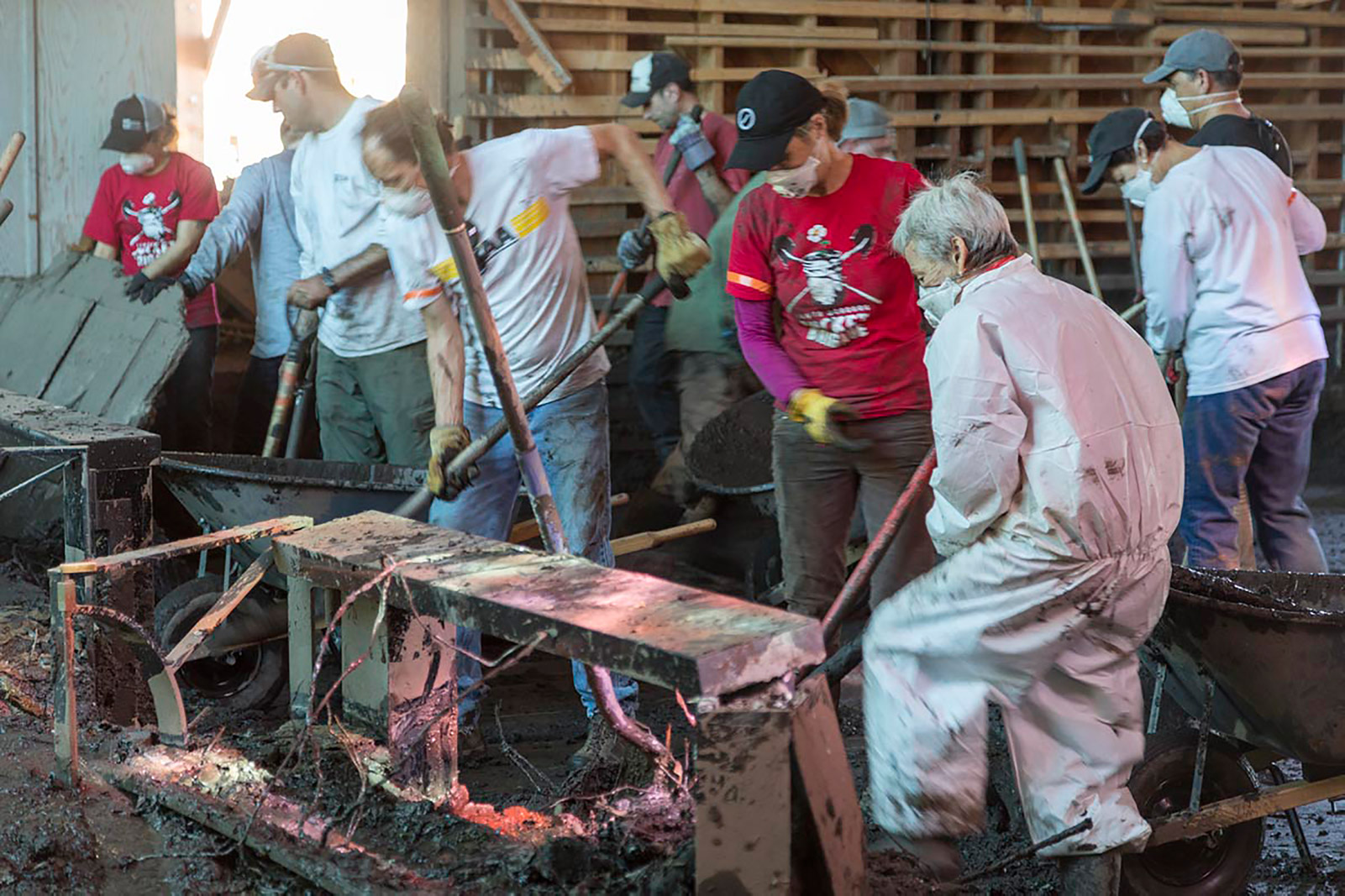
On the first day I volunteered with the Santa Barbara Bucket Brigade, my grief took the form of a labyrinth. I had spent the day shoveling mud from a guest room in a lodge at La Casa de Maria, an interfaith spiritual retreat bordering San Ysidro Creek in the Montecito foothills. During the early-morning deluge of January 9 — which killed 23, destroyed around 50 homes, and damaged hundreds more — the creek had overflowed catastrophically with mud, boulders, and trees, inundating half of the retreat’s 26 acres, razing a few buildings, and badly damaging another handful, including its main chapel.
It had been a month since the storm, and the mud inside the lodge was the consistency of peanut butter and the color of black soil. The room was only big enough for three volunteers, including me, and two wheelbarrows, which we filled up using flat shovels and took turns rolling out the door and dumping into the courtyard. Working with me was a man in his fifties, who grew up mucking dairy barns in the San Joaquin Valley, and a twenty-something woman who said that, aside from the sense of purpose she felt while helping others, working large muscle groups countered the crippling hunch of her full-time desk job.
Steadily we shoveled through the middle of the room before reaching a bed and small chair against the wall. I grabbed the chair arm, figuring I could tug it from the mud with little effort. It was stuck. Four smooth, skinny wooden legs held fast by 18 inches of pasty sludge. I yanked harder. It didn’t budge. I shook my head, pretended to laugh, and murmured a few choice cuss words, thinking, What’s wrong with me? Why am I not strong enough?
At day’s end I walked solo along the single-lane road that loops through the property. I came upon La Casa de Maria’s labyrinth, a circular path laid out in small stones, its center described in a nearby pamphlet as “a place of illumination … to receive what you came for.” Bone-tired from a day of heavy lifting, I slowly walked the labyrinth path as afternoon sunlight angled through quiet oaks. The simplicity of basic forward motion freed my mind to wander. Suddenly the labyrinth became a maze, and I was alone with the burden of my human weakness. But I never stopped walking. I stayed between the stones and every so often glanced to the middle of the circle, where previous visitors had built a small collection of polished rocks, sea glass, seashells, coins, and pinecones. Among the offerings, I noticed a bracelet of tiny lettered cubes spelling a word I couldn’t read from afar; when I arrived at the center, I looked closer: acceptance.
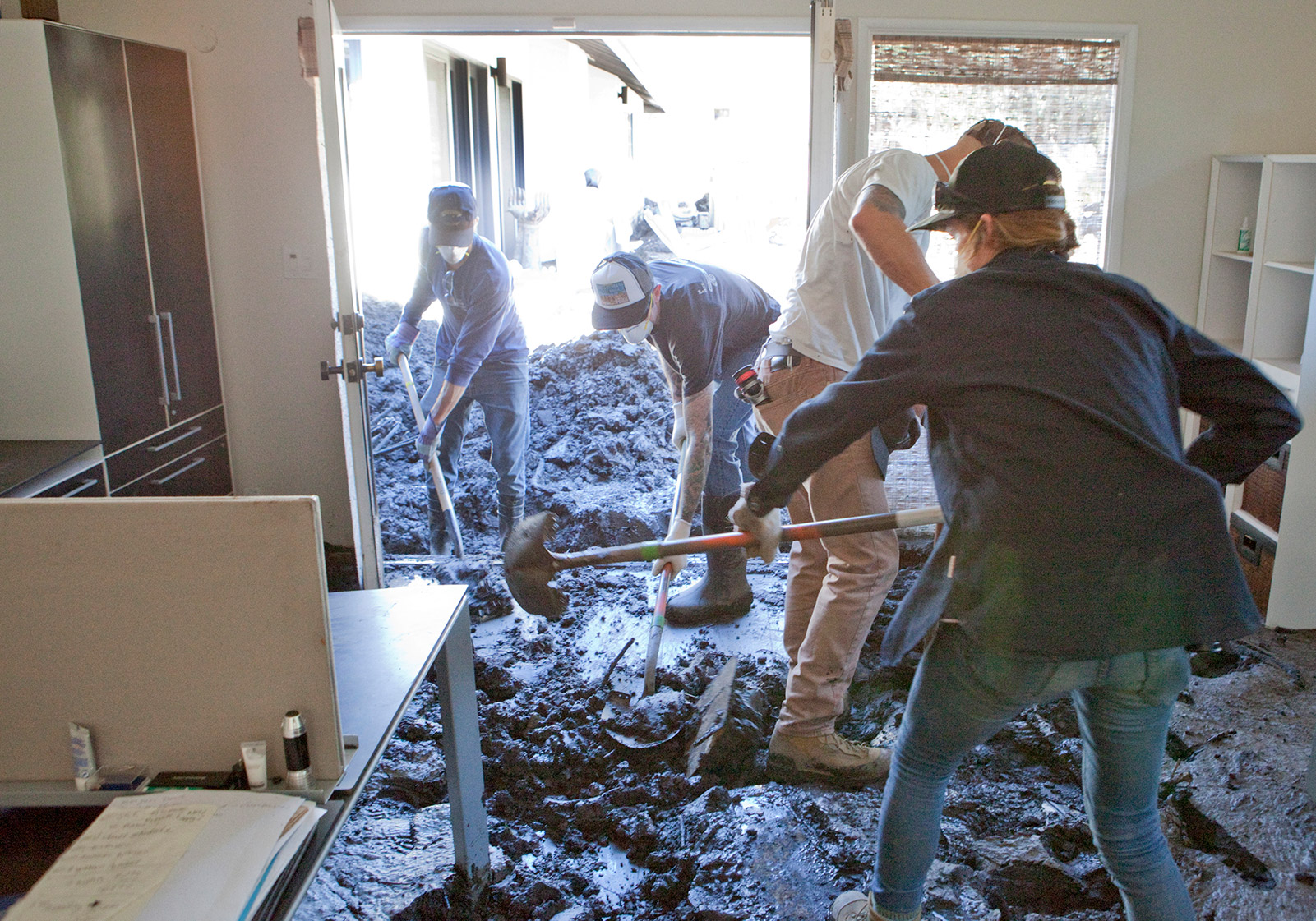
The Santa Barbara Bucket Brigade’s first iteration formed after the El Niño rainstorm on January 10, 1995. Abe Powell was living in a trailer on Mountain Drive when the region got pounded by that “monster rain event,” he remembered. “All of Mountain Drive from Cold Spring to Gibraltar was knee- to waist-deep in mud. I couldn’t drive out of my driveway for seven days.”
Powell and his neighbors had a collective “What are we going to do?” moment, which quickly materialized into a series of work parties — complete with food and beer — to “just dig each other out, one by one,” he said. At the end of each workday, they’d regroup for a potluck, “where neighbors that didn’t even like each other started liking each other a little bit,” he said. “That was the seed of the Bucket Brigade. We realized that whatever this is that we’re doing — it works.”
Fast-forward to November 13, 2008. Howling sundowners reignite a bonfire abandoned by partying college kids trespassing on the Tea Gardens property above Montecito. By the time the Tea Fire was fully contained five days later, 210 homes were reduced to ash, including the family home belonging to Powell’s mom, Christie Johnson.
As families sorted through the wreckage, “a big Pineapple Express rainstorm was heading our way, just 10 days after the fire,” said Powell, who was president of the Mountain Drive Community Association at the time. “I appointed myself the relief coordinator and created that email address [teafirerelief@gmail.com]. We organized a huge sandbagging event, and 500 volunteers showed up in one day” to buffer homesites and roadways with sandbags and straw wattles. Around 10 a.m., the workforce started to get hungry. Somebody made some calls. By noon, pizza parlors and sandwich shops had delivered free lunch for all. “Long story short: We made it through the storm,” Powell remembered. “That was the first real Bucket Brigade.”
Fast-forward to December 7, 2017. The three-day-old Thomas Fire was heading for Santa Barbara. Powell — now on the board of directors of the Montecito Fire Protection District — posted a heads-up on Facebook, urging friends to sign up for Santa Barbara County’s Aware & Prepare emergency updates. For the next 10 days, as firefighters held the line at the very edge of Carpinteria, Summerland, and Montecito, Powell’s social media updates provided levelheaded, reliable information to his growing number of followers.
As the Thomas died down, Powell’s feed went fairly quiet over the holidays. Then, on January 3, as the now-historic storm system approached, he wrote this: “We are very concerned about the potential for flooding in the communities below the burn area this winter and for the years to come.” By the time the weekend rolled around, he was heading up sandbag operations at lower Manning Park and politely telling anybody who would listen to evacuate well ahead of the coming rain.
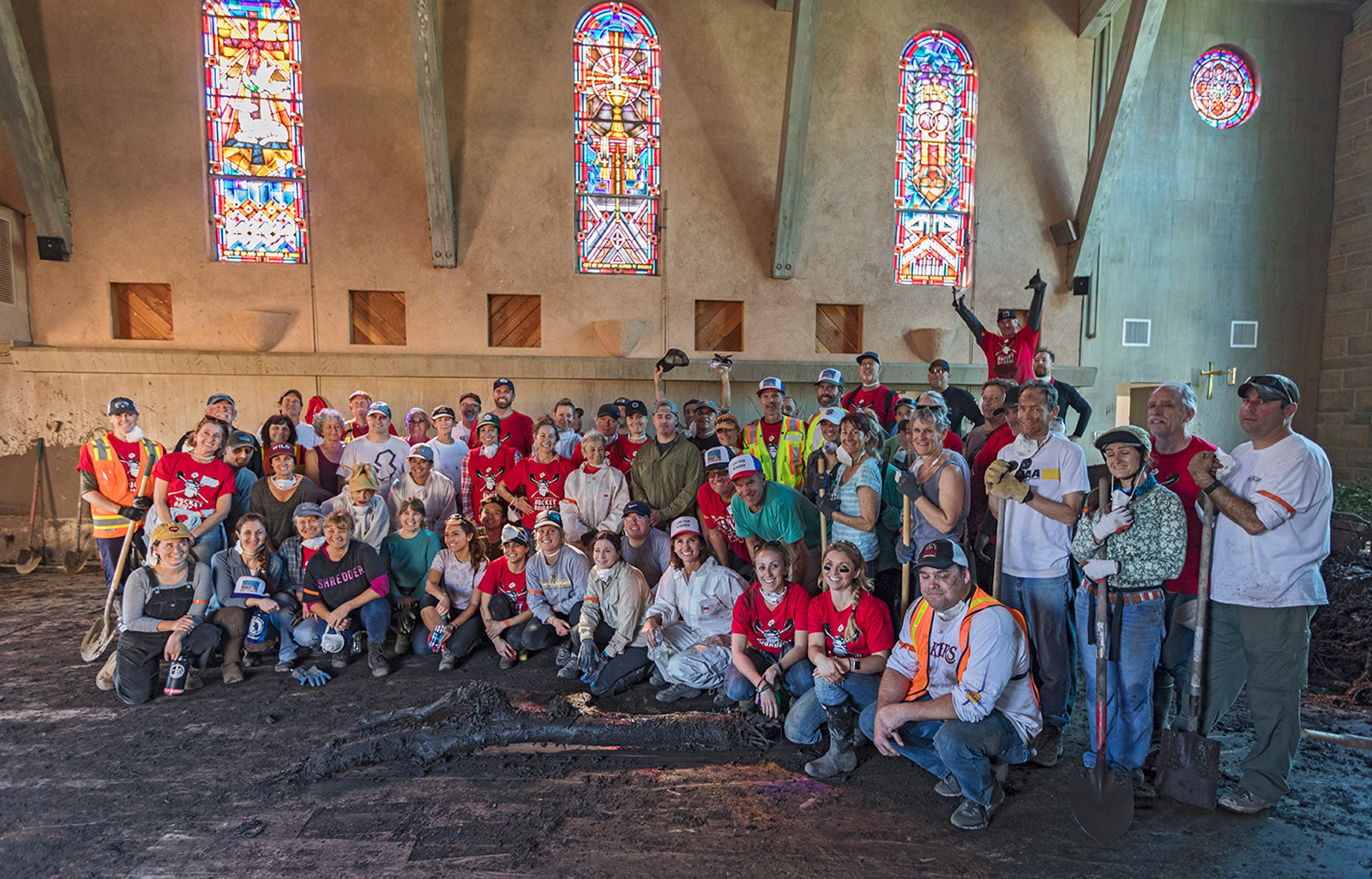
On January 5, 2018, I covered the press conference about the predicted deluge and Santa Barbara County’s new interactive flood map. At home in Montecito that afternoon, I punched my address into the map’s search feature and was relieved to see it marked outside predicted flood zones. On the afternoon of January 8, I sandbagged outside my garage, which I always do before a big rain, and battened down various hatches.
My family and I were among the very luckiest. I remember waking up at 4:07 a.m., my silenced phone glowing on the bedside table. Numerous emergency alerts were stacked up on its screen, and our next-door neighbor had left a message saying there was a big fire close by. Without waking the kids, my better half and I shuffled to the living room, where through the big window we could see giant plumes of orange flame swirling above the tree line in the pouring rain. The water in the air reflected the fiery glow, turning the night into a red dawn.
I was having difficulty making sense of what I was seeing. I pulled on pants, shoes, and a raincoat and ran the few blocks to the intersection of San Ysidro and East Valley roads. From there I estimated that the fire was a mile up the mountain. I noticed a few other people in rain gear — one person was running — and the streets were scattered with small branches and shallow mudflows. For me at the time, none of that registered as something catastrophic. At around 5 a.m., as the flames on the mountain died down, I went back to sleep.
We all woke up to the sound of low-flying helicopters racing back and forth between Santa Barbara and Montecito. The power was out, and water pressure was low. I grabbed a pen and notepad and power-walked in the rain to Montecito Fire headquarters. Deep eddies of mudflow covered parking lots and driveways and had knocked down signs and fencing and jostled parked cars. This is serious, I thought, but I had no idea that there were confirmed deaths and dozens still missing. At the fire department, everybody was on high alert, responding to literally hundreds of 9-1-1 calls and trying to make sense of the growing magnitude of the disaster.
As the rain died down mid-morning, we took the family car down San Ysidro Road, noticing that east-west arteries were either officially shut down with barricades or unnavigable because of deep mud littered with boulders and uprooted trees. It wasn’t until we made it to All Saints-by-the-Sea Episcopal Church, which had spontaneously transformed into a shelter and triage center, that death and loss started to sink in. People soaked in mud and carrying pets and backpacks were stumbling into the church parking lot, traumatized, some of them looking for lost family members.
With phone service spotty, I called in what information I could gather to my editors in the Independent’s downtown office. But overwhelmingly I felt stuck, rendered professionally inept by the mounting news — most of it bad — and torn between reporting the story, wanting to help the cold and scared, and keeping my family out of harm’s way.
The day after the storm, I texted Powell that I was willing and able to help look for the missing. He’d gotten a lot of texts like that. He told me what he told everybody else: Hold tight and let the search-and-rescue pros do their work — there’ll be plenty of time later to help dig out homes and vehicles. On the afternoon of January 11, when the Sheriff’s Office evacuated the whole of Montecito, my family and I packed up and moved into a downtown hotel. In the coming weeks, especially among the evacuated, I noticed that everybody I met was feeling as I was — exhausted and raw.
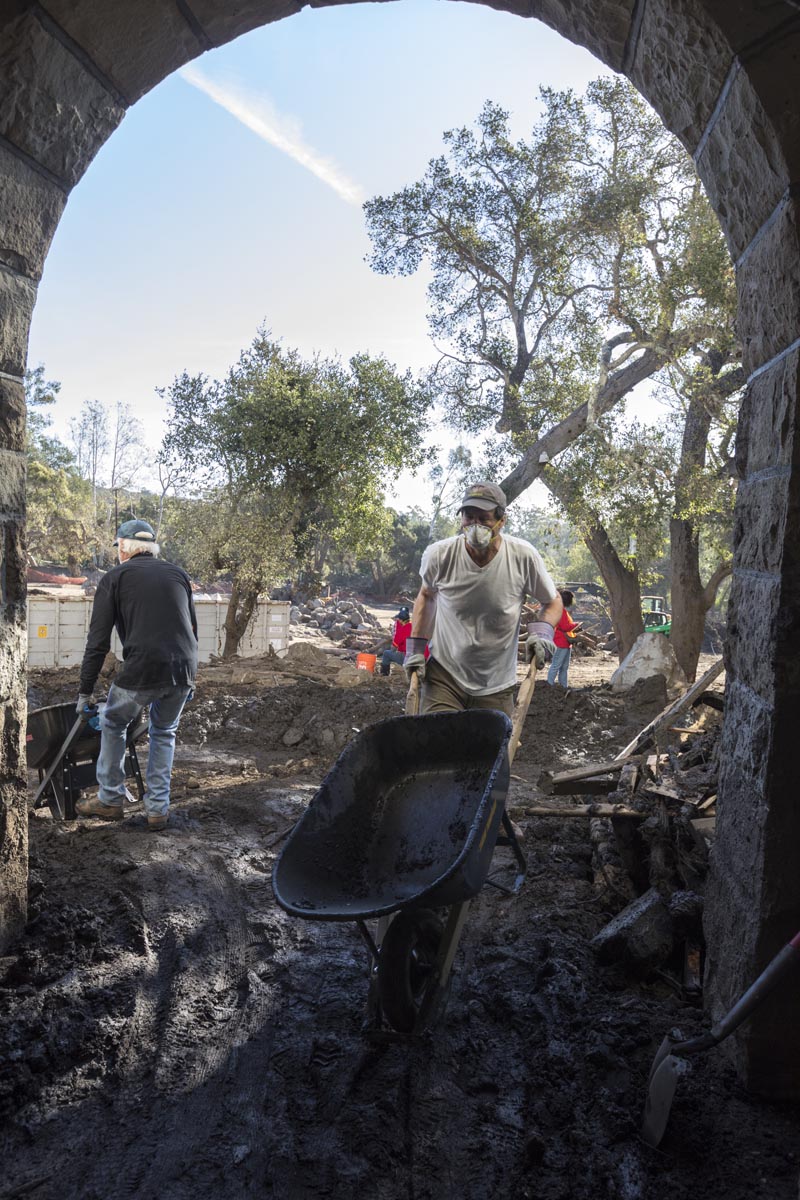
On January 26, the day after officials lifted evacuation orders throughout Montecito, Powell and his wife, Jessica Powell, fired off a few texts to friends, including Thomas and Linda Cole, and Powell posted on Facebook: “Do you need help digging out your house full of mud? We can help! Contact us – Santa Barbara Bucket Brigade: teafirerelief@gmail.com.”
Eight hours later, they had 60 volunteers signed up for an all-day Sunday dig-out of a friend’s family home in the Oaks neighborhood. Within a month, the number of volunteers approached 2,000, including carloads from Ojai, Ventura, Monterey, and Los Angeles and a retired couple who had rerouted their cross-country road trip.
“I thought it might last a week,” Powell said recently. “But now it’s like, ‘Oh, shit! We’ve started a movement!’”
On another day of volunteering, this time at a red-tagged private residence near Riven Rock, my grief took the form of a badly damaged three-car garage. A flood of mud, acorns, branches, and boulders the size of curling stones had blown out one garage door and swirled inside with such density that both cars were afloat several feet from their proper parking spots. A structural post supporting a section of the garage was badly buckled, lending a dangerous fragility to a space strong with the smell of slow decay.
My mind was quick to relent: It’s too big a task. The sheer volume of mud weighed me down with doubt. And between me and that garage, there was an entire motor court filled with tree trunks, gnarled branches, railroad ties, windowed doors, heavy household appliances, and splintered lumber spiked with hidden nails. Fortunately, I wasn’t alone. We were a crew of six, and we waded in together with shovels, picks, and digging bars. Powell’s uncle, Anders Johnson, soon followed, operating a small skip loader with, as Powell likes to say, “wizard-level” precision. Growing up in the hills of Montecito, he learned how to help himself and others get out from under wildfires, El Niño floods, and Mountain Drive landslides. Johnson was quietly leading by example that morning, one big scoop at a time.
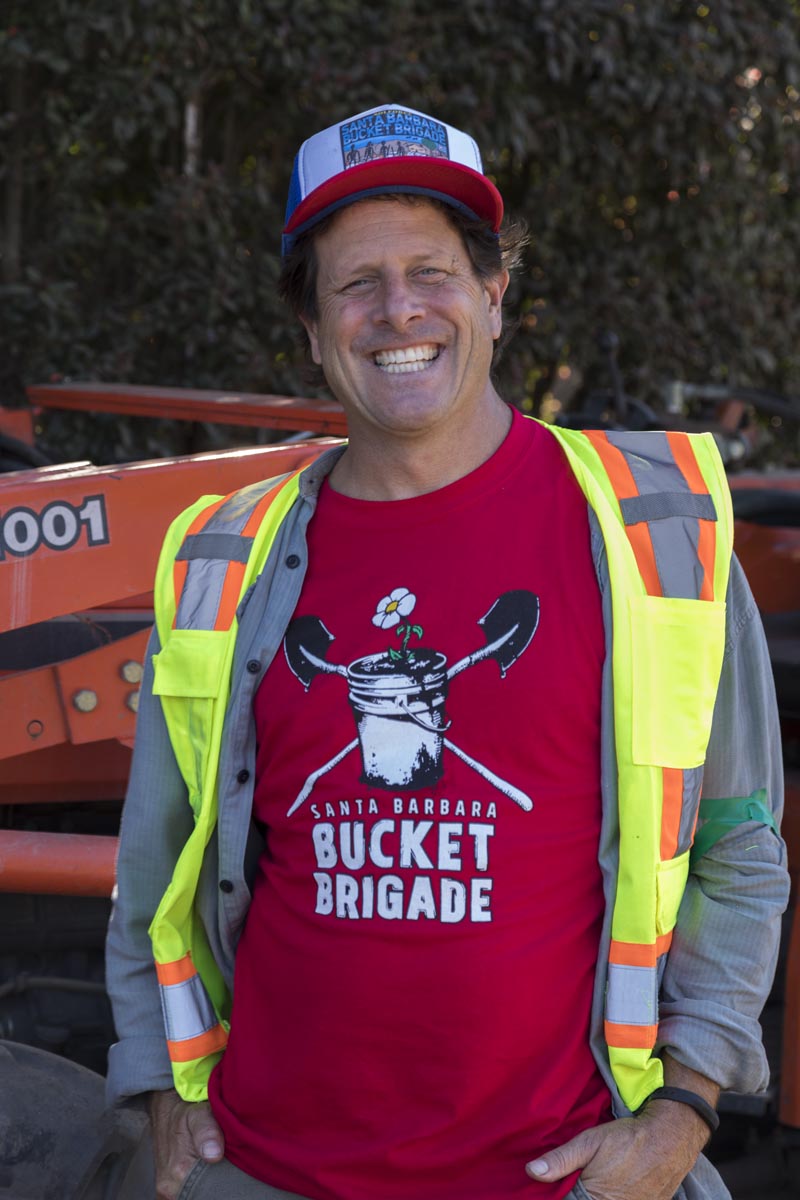
At midday, we sat on tailgates, chugged bottled water, and ate donated burritos and sandwiches made that morning by another crew of volunteers in a restaurant kitchen in town. After lunch, we stood in a circle as Thomas Cole, our crew leader, gave us a quick pep talk and site-safety refresher. Right before it was time to get back at it, a car pulled up the driveway. Out of the passenger side stepped an elderly woman — the widow of the gentleman who had died there on the morning of January 9. With her daughter holding her forearm, she walked to our circle, smiled at every single one of us, and said thank you. Time seemed to pause for a moment, as if to capture a still picture of all of us crying softly.
Back outside the garage, I grew concerned with the buckled post. It was unstable, and if it came down, a section of the building would collapse. After clearing much of the motor court, Johnson dragged both cars from the garage with a heavy chain fastened to his loader. We were getting ready to move inside, but first I needed to do something about that post. I climbed a nearby pile of trash lumber, fished out an eight-foot-long 4×4, and asked the widow’s son-in-law to cut it to 84 inches with his chainsaw. Then, hammering it with a 10-pound sledge, I wedged it vertically next to the buckled post, shoring up the damaged portion of the garage. I grabbed a shovel and got to work inside. I felt safer, and I think the others did too. We just needed some support.



